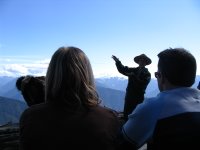Slugs and Bugs
Olympic National Park and the surrounding Forest Service and state park areas offer a wide variety of ecosystems, elevations, weather, and plant and animal life. The three major environments that you can explore here include the coast, the temperate rainforest and the mountains. The Olympic Peninsula is huge and you have to drive the perimeter, as no roads go through the interior.
We ran across many banana slugs, in yellow, green and black, and this interesting camo-colored one.
We spent two nights in the Hoh Rain Forest and one night near Hurricane Ridge on the drier eastern side of the peninsula.
In the Hoh Rainforest, we hiked about 8 miles into the backcountry towards the Olympus Ranger station, on a trail that roughly follows the Hoh River, which is icy cold and grayish blue with “glacial flour” – the powdered remnants of rocks pulverized by the glacial ice in the mountains that feed the river. I finally understand what is meant by “old growth forest” – we walked by trees that were hundreds of years old – some thousands of years old – and bigger around than our old apartment in Phoenix. The trail took us past waterfalls and meadows, and a thousand shades of green.
There is no sleep as sound as one after a 16 mile hike, and after we woke up we drove around to the other side of the peninsula and headed up towards Hurricane Ridge, scoring a spot in the fabulous Heart o’ the Hills NPS campground, where twelve bucks got us a soft, moss-covered and level site amidst towering conifers. We learned about the Olympic Marmot (which lives no where else on this planet) at a great ranger talk on Hurricane Ridge. The talk raised issues of how species interact to keep each other in check. Because there are a lot of ranches on the Olympic Peninsula, wolves were hunted, trapped, poisoned, etc. until they were gone. Then coyotes, not native to the region, moved in. Wolves hunt big animals like elk and deer. Coyotes hunt smaller animals, for example, marmots. This disruption in the food chain is causing a decline in the numbers of marmots that live here. The ranger told us that reintroduction of the wolf is possible, but that there is no money to carry out such a project.
We learned about the Olympic Marmot (which lives no where else on this planet) at a great ranger talk on Hurricane Ridge. The talk raised issues of how species interact to keep each other in check. Because there are a lot of ranches on the Olympic Peninsula, wolves were hunted, trapped, poisoned, etc. until they were gone. Then coyotes, not native to the region, moved in. Wolves hunt big animals like elk and deer. Coyotes hunt smaller animals, for example, marmots. This disruption in the food chain is causing a decline in the numbers of marmots that live here. The ranger told us that reintroduction of the wolf is possible, but that there is no money to carry out such a project.
This area is undisputedly one of our favorites, and we hope to return to do more backcountry exploration.



2 comments:
How big is that slug??? It was hard to tell in the picture so I am imagining creatures the size of small cars oozing their way through the forest. Yuk!
Well, I'd say it's probably about 6-8" long, and maybe 1" across. They're definitely pretty big. There are smaller ones, too, but all the ones in the rain forest were pretty giant.
Post a Comment